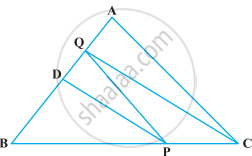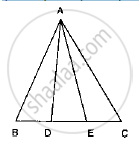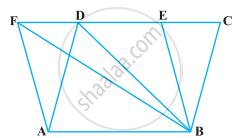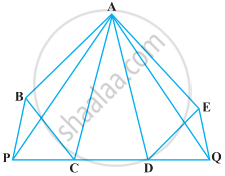Advertisements
Advertisements
Question
In ∆ABC, D is the mid-point of AB and P is any point on BC. If CQ || PD meets AB in Q (Figure), then prove that ar (BPQ) = `1/2` ar (∆ABC).

Solution

Given: In ∆ABC, D is the mid-point of AB and P is any point on BC.
CQ || PD means AB in Q.
To prove: ar (∆BPQ) = `1/2` ar (∆ABC)
Construction: Join PQ and CD.
Proof: Since, D is the mid-point of AB. So, CD is the median of ∆ABC.
We know that, a median of a triangle divides it into two triangles of equal areas.
∴ ar (∆BCD) = `1/2` ar (∆ABC)
⇒ ar (∆BPD) + ar (∆DPC) = `1/2` ar (∆ABC) ...(i)
Now, ∆DPQ and ∆DPC are on the same base DP and between the same parallel lines DP and CQ.
So, ar (∆DPQ) = ar (∆DPC) ...(ii)
On putting the value from equation (ii) in equation (i), we get
ar (∆BPD) + ar (∆DPQ) = `1/2` ar (∆ABC)
⇒ ar (∆BPQ) = `1/2` ar (∆ABC)
Hence proved.
APPEARS IN
RELATED QUESTIONS
In a triangle ABC, E is the mid-point of median AD. Show that ar (BED) = 1/4ar (ABC).
Show that the diagonals of a parallelogram divide it into four triangles of equal area.
D, E and F are respectively the mid-points of the sides BC, CA and AB of a ΔABC. Show that
(i) BDEF is a parallelogram.
(ii) ar (DEF) = 1/4ar (ABC)
(iii) ar (BDEF) = 1/2ar (ABC)
In the given figure, diagonals AC and BD of quadrilateral ABCD intersect at O such that OB = OD. If AB = CD, then show that:
(i) ar (DOC) = ar (AOB)
(ii) ar (DCB) = ar (ACB)
(iii) DA || CB or ABCD is a parallelogram.
[Hint: From D and B, draw perpendiculars to AC.]

XY is a line parallel to side BC of a triangle ABC. If BE || AC and CF || AB meet XY at E and F respectively, show that
ar (ABE) = ar (ACF)
Diagonals AC and BD of a quadrilateral ABCD intersect at O in such a way that ar (AOD) = ar (BOC). Prove that ABCD is a trapezium.
In the below fig. D and E are two points on BC such that BD = DE = EC. Show that ar
(ΔABD) = ar (ΔADE) = ar (ΔAEC).

The area of the parallelogram ABCD is 90 cm2 (see figure). Find
- ar (ΔABEF)
- ar (ΔABD)
- ar (ΔBEF)

In the following figure, ABCDE is any pentagon. BP drawn parallel to AC meets DC produced at P and EQ drawn parallel to AD meets CD produced at Q. Prove that ar (ABCDE) = ar (APQ)

If the medians of a ∆ABC intersect at G, show that ar (AGB) = ar (AGC) = ar (BGC) = `1/3` ar (ABC)
